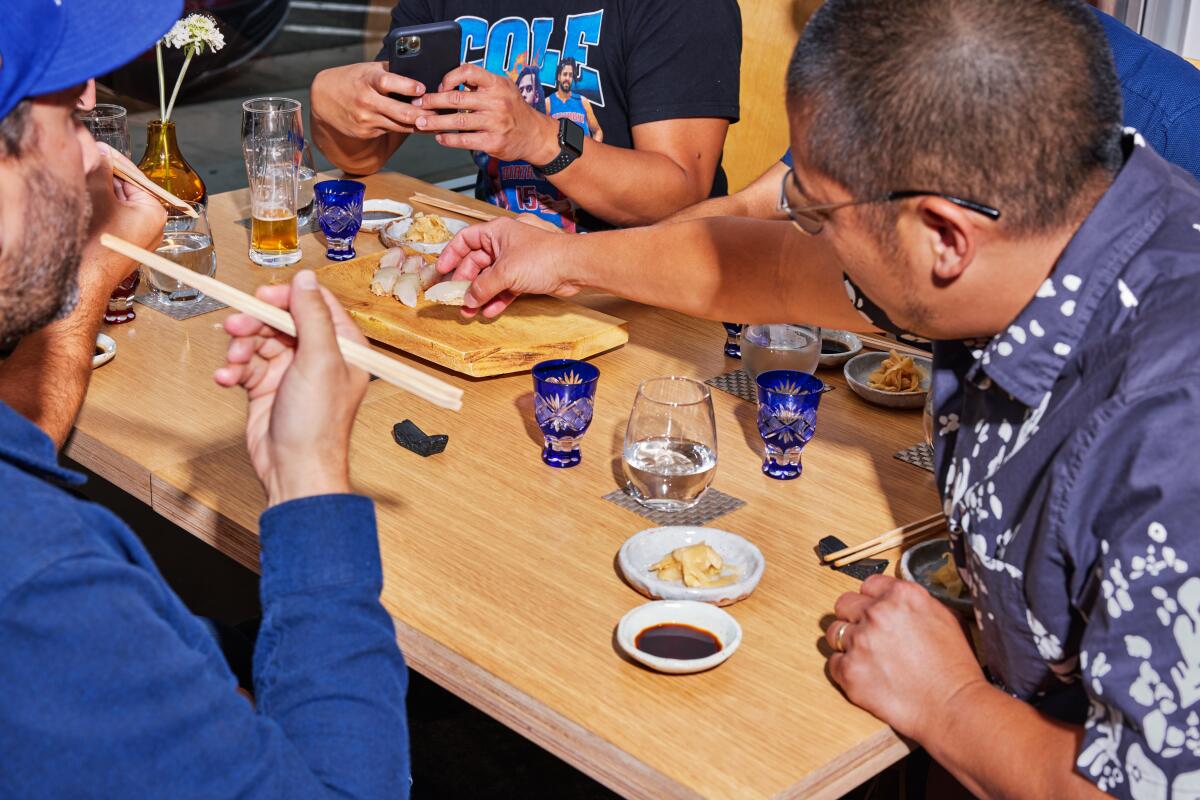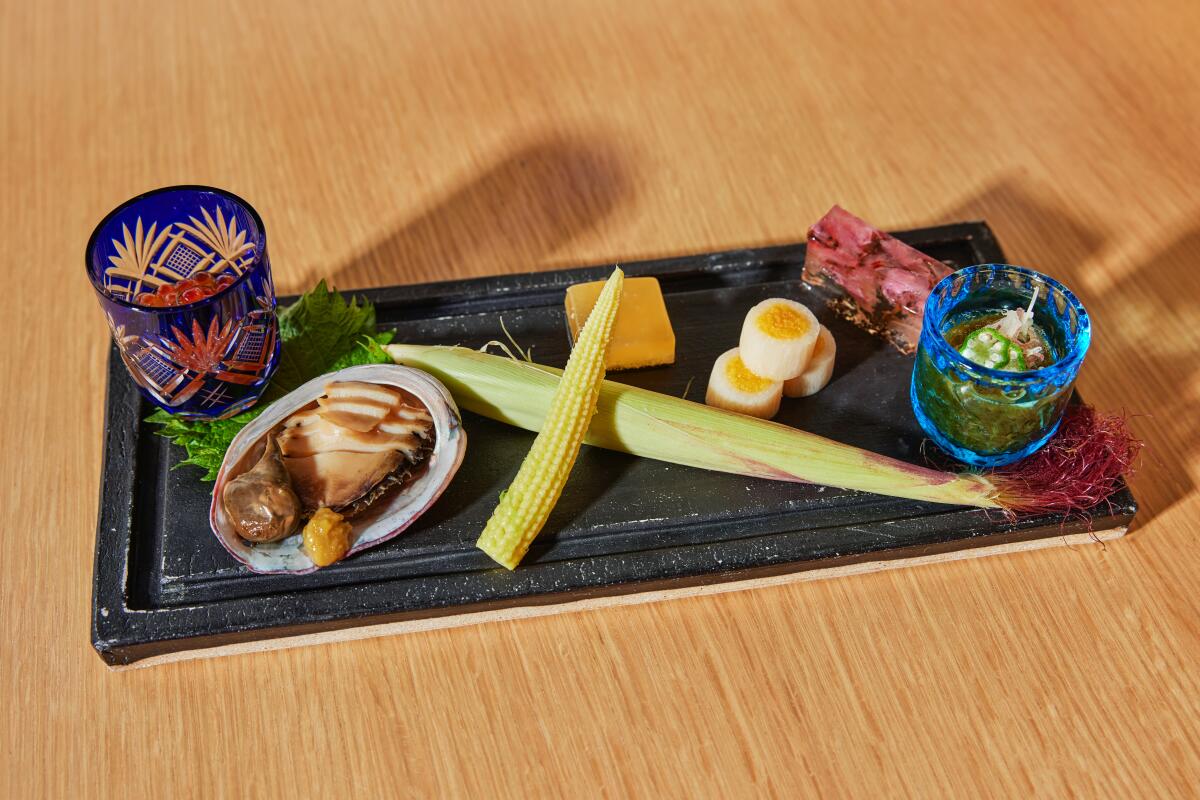Eat your way across L.A.
Get our weekly Tasting Notes newsletter for reviews, news and more.
You may occasionally receive promotional content from the Los Angeles Times.

Every piece of nigiri shaped by Morihiro Onodera’s hands reminds me to appreciate the humbler beauty beneath the shiny overlay.
In matters of sushi, the sea treasures will always vie for the limelight: uni in the soft shades of Renoir’s oranges, tuna glowing deep reds and creamy pinks, saba cut to accentuate a curving streak of silvery skin. Onodera — “Mori” or “Mori-san” to the fan base he’s accrued over nearly 40 years in Los Angeles — pays the rice underneath equal respect. His care begins at the source. Last decade he helped bankroll a farm in Uruguay growing nutty, slightly chewy rice to his proclivities. By next year he’ll be serving a variety he’s commissioned in Iwate prefecture, the region along the northeast coast of Japan’s main island where he grew up.
Until then, he’s using sweet koshihikari rice produced in the Ibaraki prefecture north of Tokyo. He polishes unhulled shipments daily at Morihiro, his tiny new sushi restaurant in Atwater Village. During service the milling machine sits like an art piece, shiny and silent, on a perch to the left of the six-seat sushi bar.

The pearly rice clumps together easily in Onodera’s palm when he forms nigiri, and separates just as readily when consumed: The grains are so distinct I could probably count them with my tongue if I wasn’t so absorbed in the collective pleasure.
If the ripple of crises over the last 17 months swiftly and mercilessly razed a top stratum of Eurocentric haute cuisine in Los Angeles (Somni, Dialogue, Trois Mec, Auburn, Lucques, Patina and Bon Temps number among the losses), our high-end sushi culture has, by and large, weathered the decimation. You can experience seasonal rarities on mesmerizing pottery at Little Tokyo newcomers Sushi Kaneyoshi and Sushi Hide; roll with the baroque, glittered stylings at Go’s Mart in Canoga Park or study Hiroyuki Naruke’s meticulous knife skills in the solemn silence of Q Sushi downtown; consider the intensifying effects of aging fish at Sushi Inaba or surrender to the seamless, fast-clipped choreography at Nozawa Bar in Beverly Hills.
Onodera has a special place in L.A. His talents flourished as the city’s tastes in sushi awakened, evolved and diversified. He arrived in 1985 and worked at two defining sushi restaurants: Katsu on Hillhurst and Nobu Matsuhisa’s Beverly Hills game-changer, Matsuhisa. Along the way he trained with Jiro Ono. For 11 years Onodera ran his own place, Mori Sushi in West L.A., which he opened in 2000. He reappeared briefly at Shiki in 2017, followed by a gig at Inn Ann, the restaurant perched in the farthest and highest corner of the garish Hollywood & Highland shopping center. The food was spectacular, even if the location felt odd to the point of fiction.
“Here is much better,” Onodera sighed across the sushi bar in Atwater Village, laughing and shaking his head.
He returned to restaurant ownership in November, and as with many sushi restaurants he floated his business by selling elaborate takeout bentos and chirashi feasts before indoor dining resumed in the spring. During the pandemic’s hardest days, when memories reared up even when I wanted to squash them back down, I dreamed of Onodera’s sushi rice. “Body temperature” is the analogy often used to describe its ideal degree of warmth for nigiri. At Morihiro that means somewhere between the heat you feel on your wrist when you take your pulse and the warmest zone in the center of your chest.
Cold from a carryout box, the rice was good. Being able to once again eat it freshly cooked as intended, though, is utterly life-affirming.

Diners choose from among three tiers at the restaurant. Four-course meals, served at one of the room’s seven tables, range from $65 to $100, depending on the amount of sushi. They include small appetizers — likely pickles, a square of homemade tofu and other daily whims — with miso soup and a small dessert. A $45 version centers around three sushi rolls. These are satisfying meals, full stop.
An extravagant omakase, an investment of appetite and funds, costs $250 per person at a table and starts at $350 per person in front of Onodera at the sushi bar. If that price makes you blink, or scowl, know that devotees keep the sushi bar seats booked for weeks out. (It’s the same, online sleuthing tells me, at first-rate sushi restaurants across L.A. charging similar amounts.) I slipped in on a Sunday night when there happened to be a cancellation.
Sitting in the middle of the action, facing the master, felt like dropping in on a workshop in full production mode. Stacks of ceramics on three rows of shelves behind him emphasized the impression; Onodera has been making his own earthy, elegant tableware for much of his career. He stood at the counter surrounded by sous chefs Lily Sugiyama and Yoko Hasebe and pastry chef Laura Ochikubo. They worked calmly and furiously. Some sushi bars radiate serenity, or gravity. This scene exuded a chaotic sort of warmth. The realness pulled me in.
First dish: homemade tofu, made with particularly sweet soy milk from Kyoto, crowned with a dot of freshly grated wasabi and set in a pool of soy sauce. It came in a glossy bowl the color of a robin’s egg with a speckled brown glaze around the inner rim. The presentation amplified the tofu’s smoothness; it was as custardy to the eyes as it was to the palate.
At least five more starter courses arrived apace. A zensai plate held small tastes that burbled as much with texture as flavor: marinated salmon roe that burst on the roof of the mouth; slices of steamed abalone paired with yuzu koshu for bright, peppery blasts; a long, slim, al dente ear of baby white corn; seaweed in vinaigrette with okra and the Japanese ginger called myoga; and startlingly beautiful salt-cured cherry blossoms suspended in plum wine gelatin.

Between the sashimi of Hokkaido scallop and the mound of big-eye tuna tartare dolloped with a heaping tablespoon of caviar, I wondered if I might be starting to feel full.
Then the procession of nigiri began. I took a picture of the silvery saba, sliced to evoke a serpent’s tail slithering onto its mottled plate.
I told myself to put down the phone and be present. Onodera’s charisma is part of his legend. One minute he’s as serious as a jeweler perfecting a ring for his own dearest. The next he’s as casually jokey as your coolest uncle.

I watched and remembered how his hands have minds of their own. His eyes are taking in customers coming through the door, noting the pacing of his team, nodding to manager Tokiko Binkley as she pours a daiginjo sake with unmistakable banana notes. His fingers and palms keep working — forming nigiri, or molding rice and crinkling sheets of seaweed into rolls.
He placed each piece in front of me. I reached out to match his rhythm. We settled into the communion that hard-core sushi adherents live for: the cool (and sometimes gently warmed) seafood against fleshy rice, the tingling blaze of freshly grated wasabi, the intimacy of the exchange and the anticipation of what comes next.
During a grouping of fishes in the mackerel and herring families, Mori-san pointed out the kohada, or gizzard shad. Curing and vinegar teased out a hanger-steak-of-the-sea meatiness. “It’s my favorite,” he told the group. “Jiro’s favorite too.”
The night’s conclusion neared. After a hand roll filled with kanpyo (strips of sweet squash), Onodera asked the four of us remaining at the bar if we’d like more of anything. One of the couple next to me furrowed his brow. “We’re so full we can’t eat anything else,” he replied. “Please don’t blacklist us.”
While those of us with more room ate delicate mochi molded around matcha ice cream, Ochikubo pressed fresh taiyaki (fish-shaped waffles) for us to take home for breakfast. Often they’re filled with red bean paste; this night they oozed strawberry jam.

More than three hours after dinner began, I took one last sip of sake, exclaimed my thanks to Mori-san and his crew as they beamed back and finally staggered out of Morihiro. I gazed into the night — at El Buen Gusto restaurant across the street, at the Out of the Closet thrift store up the block and toward the mountains looming invisibly in the black distance.
This is what fine dining in Los Angeles is all about, I thought. Walking to the car I pulled the taiyaki out of its takeout box and burned my tongue trying to eat it. Didn’t matter. It was still delicious, and nothing could ruin the moment.

Morihiro
3133 Glendale Blvd., Los Angeles, (323) 522-3993, morionodera.com
Prices: four course dinners $45-$100; omakase served at table $250 per person; sushi bar omakase $350-$400
Details: 6-9 p.m. Wednesdays-Saturdays, 5-8 p.m. Sundays. Sake, beer and wine. Credit cards accepted. Street parking.
Eat your way across L.A.
Get our weekly Tasting Notes newsletter for reviews, news and more.
You may occasionally receive promotional content from the Los Angeles Times.